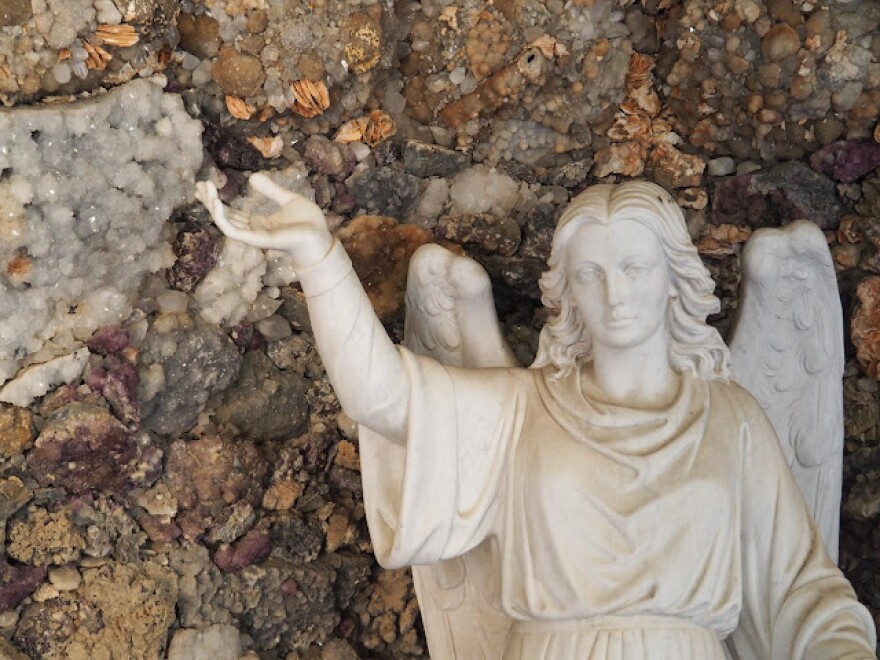I'm proposing a small, strange road trip. Stay with me.
Father Paul Matthias Dobberstein designed The Grotto of the Redemption from the story of shepherds who carved places of worship into caves and crevices, then decked them out with icons. Thus, grotto has come to mean “a holy place.”
Now Iowa has holy places galore, but only one Grotto. Its ancestors are all in Spain or Portugal. No matter, let's go on a road trip, a little architectural tour. Come on along.
But first, Mason City. The most famous American architect left behind a dozen or so creations in Iowa--really distinctive places because, well, Frank Lloyd Wright was distinctive. Mason City's George Stockman House is open year round for tours.
The Stockman House has flat lines and an odd roof and sits in a peculiar squat stance. Wright created something that seems to grow from the setting, like some huge, square-cut vegetable, almost as if the place was bedecked in camo. It’s a building so comfortable in its setting you get the eerie feeling the place mushroomed up of the ground. Mason City is doubly blessed with another Wright creation, the Park Inn Hotel. If we need an overnight, we'll take one therein.
There's nothing but cement all around the place, but when you see it, you can't help but note Wright's characteristic flat-land view, something called “the prairie style.” “The prairie style" may well suggest something familiar: Sioux City's own Courthouse, whose distinctive character was drawn up by the same Chicago "school" as the Stockman House and Park Inn hotel. Kissing cousins almost.
But we’re on a road trip here, so right now you're thinking Adventureland next? Nope. Leave the kids home. Go straight east from Mason City, and we can stop off at Algona to take in the memories of a huge prisoner-of-war camp AND the Algona Nativity. Amazing thing. But if you don't have the time, it'll take you a good hour-and-a-half to get to West Bend, a town that glories in its grotto the way Orange City flashes its Tulip Festival—but West Bend's pride never closes. Seriously.
The Grotto is almost merciless in piety. Some call it "the Eighth Wonder of the World." The story goes that when a bout of pneumonia put Father Dobberstein at death's portal, he prayed and prayed to the Blessed Virgin, promised her that if granted recovery, he'd for sure put up a shrine. Did he ever.
The Grotto of the Redemption is a proud mound of shining stones and petrifactions that annually leaves a hundred thousand visitors google-eyed. It's a miniature mountain of precious stones sculpted into holy caves, all of it created from Father Dobberstein's rock-solid devotion. Took him a lifetime and more--he had help, from here and above. It's a monstrosity of devotion, a preposterous pile of precious stones, any one of which emits glory, an amazing place, a holy, goofy creation.
Dobberstein's statue stands off a corner, looking more like a geologist than a priest in his baseball cap and zippered sweater, a chunk of quartzite in his proffered hand. His huge grotto may well be "the Eighth Wonder of the World." I'm not sure it even has a rival.
Wright's creations grow out of the earth they inhabit, but there's nothing about Dobberstein's grotto that comes from Kossuth County. Wright’s creations are all about the here; the Grotto is about the there. Frank Lloyd Wright only saw what was all around him; Father Dobberstein's is pure spiritual vision.
They're polar opposites, those two. Who says Iowa is monoculture? I don't know that the stops on this particular road trip could be more abidingly different. So what do we make of all this? Mary Oliver, the poet, pulled soul-full inspiration from a blue iris. But, she said “It doesn’t have to be the blue iris, it could be weeds in a vacant lot, or a few small stones, just pay attention… There's the joy, maybe.
We've just seen some visions. "Just pay attention," the poet says. I like that. Tell you what, on the way home get back on 3 and stop in LeMars for ice cream.




